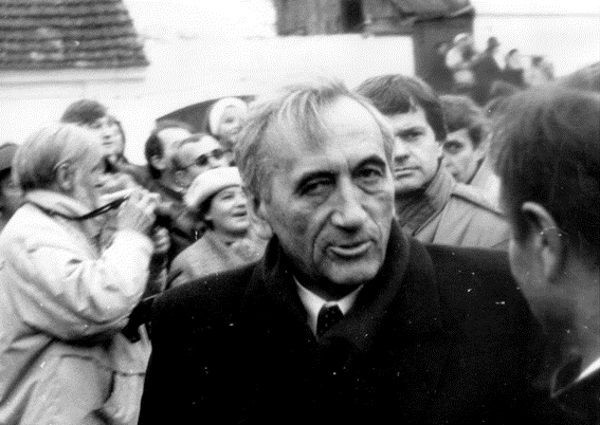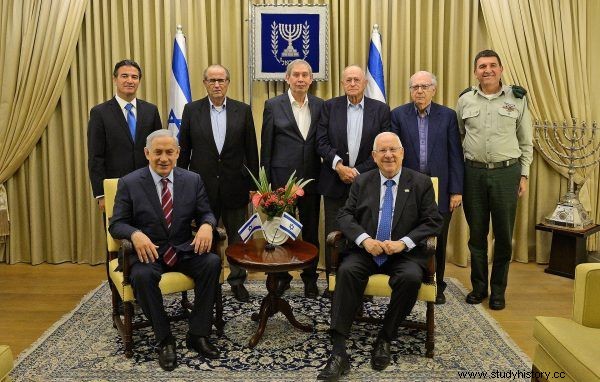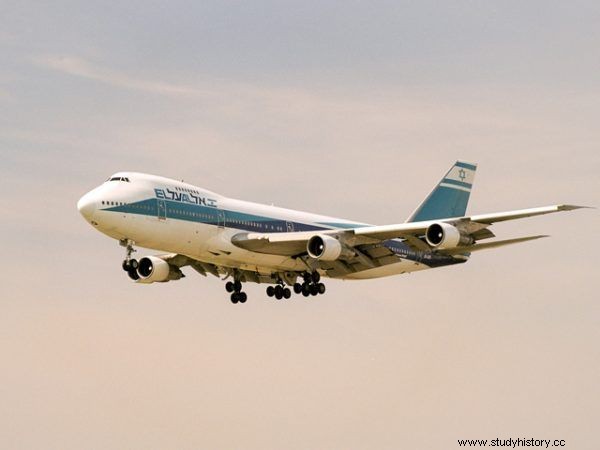For two years, the Polish secret services conducted a secret operation, the scale, scope and degree of danger of which were unprecedented. Despite these difficulties, the action was a complete success. What was it about and how did it come to entrust it to us?
In the summer of 1988, a new intelligence report was sent to the desk of the then Prime Minister of Israel, Yitzhak Shamir. It drew attention to the dangers that could threaten Jews living in the Soviet Union at the time of the collapse of the Soviet state. At the end of the 1980s, the USSR was plunged into a serious economic crisis, and Gorbachev's perestroika it additionally weakened him internally and externally.
Israeli intelligence analysts predicted that the possible disintegration of the Soviet state could result in political and social disturbances, and even bloody ethnic fights. In their opinion, the victims could be Jews, of whom almost 2 million lived in the USSR at that time.
Thus, Prime Minister Shamir began diplomatic talks with Moscow through the Americans. Their goal was to obtain permission for the emigration of Soviet Jews. In return, Tel Aviv and Washington promised to ease economic sanctions on the USSR since the invasion of Afghanistan and to grant loans . In line with his liberalization policy, but also tempted by economic benefits, Mikhail Gorbachev agreed, on condition, however, that the emigrants would renounce their property left in the USSR.
Poland will not dodge ...
For the sake of appearances, departures were to take place through a third country through which the transit would take place. Moscow did not want to jeopardize its good relations with the Arab states, which looked wry at any contacts with Israel. Initially, departures were made via Vienna, but the airport there was too busy to keep the operation a secret. Romania and Hungary were therefore asked to do so. Bucharest did not agree, however, and the Hungarians withdrew after a bomb attack against one of the immigrant groups, which killed a policeman.

The government of Tadeusz Mazowiecki agreed to the participation of Poland in the operation.
The third country that Israel turned to was Poland. From September 1989, a new government headed by Tadeusz Mazowiecki was active there. In February 1990, the previously quarreling states resumed diplomatic relations that had been interrupted in 1967. The new team completely changed the current policy, which was reluctant towards its partner from the Middle East.
In such a situation, on March 8, 1990, the Israeli embassy made an official request to the Polish authorities for help in carrying out the emigration. Departmental consultations and analyzes of the related benefits and risks, as well as technical issues, have started. Various estimates of the number of future immigrants appeared in the interviews: from 250 to even 850 thousand people .
On March 26, 1990, Prime Minister Mazowiecki, who was visiting the United States, was received in New York by the American Jewish Congress. The prime minister apologized for the anti-Zionist campaign of 1968 and offered to help in the matter of emigration. "Poland will not refrain from humanitarian aid to emigrants from the Soviet Union" He said.
Terrorists are threatening Poland
By declaring participation in the action, the authorities of our country took a considerable risk. For many years, the People's Republic of Poland maintained political, economic and intelligence contacts with Arab states. It also supported - similar to other socialist countries - terrorist organizations fighting against Israel.
Members of these groups (including prominent ones) came to Poland for treatment, rest and training. Some of them lived here, did business, were educated. Therefore, there was a serious risk that, using their contacts, they would learn about the action and make an attempt to counteract it. The fact that the threat was real is evidenced by the event that took place four days after Mazowiecki's declaration in New York. On March 30, the car, which Bogdan Serkis, the commercial attaché of the Polish embassy in Lebanon, was getting fired on with a machine gun. Passengers were seriously injured. The organization of the Revolutionary Action pleaded guilty to the attack.
In turn, two days later, the Islamic Military Front announced that it would launch attacks on Polish diplomats, as well as LOT's foreign missions and offices, if Poland did not withdraw from helping Israel . On the other hand, in Warsaw, the ambassador of Egypt, on behalf of the Arab states, officially expressed his concern about the rumors about Polish emigration cooperation with Israel.
The Polish authorities were aware of the enormous risk they were exposing themselves to. That is why the secret services took very seriously the preparation of the operation, which was given the name "Most". On March 29, representatives of the Ministry of Foreign Affairs, the Ministry of the Interior, the Office of the Council of Ministers, the Ministry of Transport and LOT met at the meeting. It was assumed, inter alia, that the costs of the action must be borne by Israel. The basic condition for its conduct was to ensure the safety of Polish citizens, institutions and airplanes. These arrangements were presented to the Israeli ambassador who accepted them.
Mossad, Shin Bet, Sajjeret Matkal
The government issued a discreet ban on reporting the operation in the media. The services have intensified the observation of Arabs staying in Poland suspected of having contacts with terrorist groups, strengthened border control and the surveillance of foreigners. They also checked domestic nationalist and anti-Semitic circles .

On the Israeli side, Mossad officers watched over the course of the action. The photo shows the heads of the agencies.
On April 10, 1990, the Anti-Terrorist Action Coordination Team was established. It was headed by the head of the Intelligence and Counterintelligence Service, General Zbigniew Sarewicz, and his deputy was the deputy director of Department I (intelligence), Colonel Bronisław Zych. It was composed of representatives of the intelligence, counterintelligence, militia and reconnaissance of the Border Protection Forces. Major Jerzy Dziewulski, the commander of the anti-terrorist unit from Okęcie, was responsible for the practical security of the operation.
Even before the first Jewish immigrants appeared in Poland, representatives of the Israeli secret services flew to Warsaw. According to Major Dziewulski, these were officers of the Mossad (intelligence), Shin Betu (counterintelligence) and the military special unit Sajjeret Matkal. He himself was sent to Israel for a month's training, so that he could learn about the principles of operation of the local services.
Security specialists from the USA also appeared on the Vistula River to share their experiences with the Polish side. Help in organizing the campaign was also provided by the then dynamic company Art-B by Andrzej Gąsiorowski and Bogusław Bagsik . At the request of the secret services, she took care of the international money flow, and also helped in the purchase of equipment and directly at the operation itself.
The helicopter will take the rocket
Operation "Bridge" began in the summer of 1990. Jewish immigrants came in disorganized groups on the Moscow-Paris course trains. They got off at the Warszawa Gdańska station, where they were looked after by Polish and Israeli services. The newcomers were loaded onto waiting coaches and escorted by unmarked cars to a hotel rented by the embassy in Legia's facilities in Bemowo. They spent a night or two there waiting for the arrival of an Israeli plane. They were not allowed to leave the building, and the facility itself was guarded. As soon as the machine was ready for take-off - usually it was early in the morning or late at night - the emigrants were dropped off at Okęcie and then brought on board.

The emigrants left Warsaw on El Al.
Air transport was provided by the Israeli El Al airlines, which made their Boeing 747s available. Initially, it was assumed that LOT's fleet would also take part in the action, but the company had problems with chartering the appropriate planes, and some crews refused to fly to Israel . The Israeli side took care of the transport. This is the landing procedure at the Warsaw airport Jerzy Dziewulski:
Two hours before arrival, my armored personnel carriers plus Polish-Israeli crewed police cars patrol the apron. In addition, anti-terrorists surrounding the airport. In addition, jeeps and a Mi-2 helicopter are still ready. When the Israeli machine lands, we take it over on the main landing strip, then we follow the UAZs and follow the plane, we control that no one dials a number or causes an air crash . ... .
After parking, the Boeing was fenced off and guarded by Dziewulski's men. Very strict safety rules were observed. As Dziewulski recalls:
The plane opened the door, the stairs went down, and several security officers from the Sajjeret Matkal unit came out. Their task was to keep an eye on the plane. One was in the front of the plane, the other was watching the tail. The plane was impossible to approach, it was kind of extraterritorial ... Its direct protection was dealt with by the Israeli secret services.

We indicated to LOT employees that the zone it is about 30-50 meters so that, God forbid, not to be exceeded. Nobody was allowed to get on the plane. Nobody could drive up, say they had some kind of transport. Nobody could say they wanted to check or fix anything here. Every move was controlled .
An armored carrier of an anti-terrorist unit stood under the machine, two others were patrolling the taxiway. Snipers sat on poles with searchlights, and an Israeli officer was always on the control tower.
Initially, passenger check-in took place in the airport terminal, which was closed at that time. Later, however, to streamline and expedite the procedure, they were transferred to the hotel where the emigrants stayed overnight. A Polish team specially trained by Israelis, who carried out the clearance, came there. Thanks to this, the bus at the airport could drive directly to the plane. After passengers boarded, the Boeing took off and was accompanied by a Mi-2 helicopter from the side. Supposedly in order to take the rocket onto oneself in the event of the attack by the attackers .
Good case
As Jerzy Dziewulski recalls, the embassies of Arab states such as Syria and Libya tried very hard to find out the details of the operation. Their diplomats drove up to Okęcie and filmed security measures from the windows of their cars. They also tried to bribe the officers involved in "The Bridge".

"It lasted for nearly two years, during which I had practically no contact with my family," recalls operation "Bridge" Jerzy Dziewulski.
Fortunately, there were no attempts to attack or sabotage during the entire operation. The action lasted two years, from the summer of 1990 to April 1992. There are no documents with comprehensive data on the number of Soviet Jews transferred by Poland. It is estimated that it could have been from 29,000 to 40,000 people.
The Bridge was the largest action ever carried out by the Polish secret services. For Jerzy Dziewulski, it was the most difficult operation in his life. “It lasted nearly two years, during which I had practically no contact with my family, not to mention my buddies. I just spent all my nights and days working. But I know that the matter was right "- he says in the book" About kulisach III RP " .
